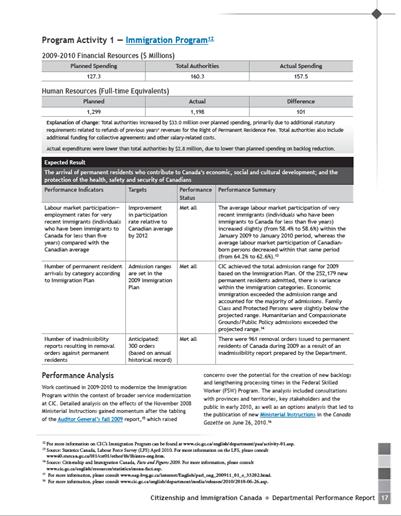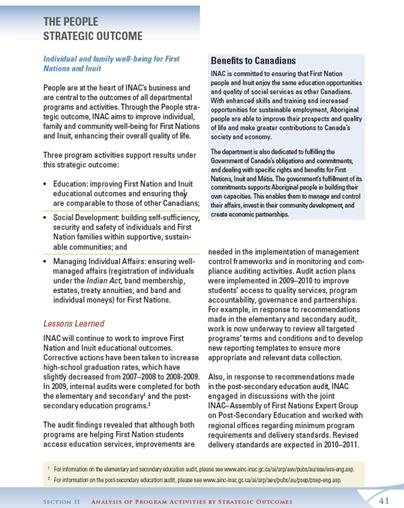Common menu bar links
Breadcrumb Trail
ARCHIVED - Performance Reporting: Good Practices Handbook 2011
 This page has been archived.
This page has been archived.
Archived Content
Information identified as archived on the Web is for reference, research or recordkeeping purposes. It has not been altered or updated after the date of archiving. Web pages that are archived on the Web are not subject to the Government of Canada Web Standards. As per the Communications Policy of the Government of Canada, you can request alternate formats on the "Contact Us" page.
Link performance to plans
At its most basic, linking performance to plans means ensuring that the RPP and DPR are consistent in terms of form and content. Reporting on the basis of the MRRS will go a long way in ensuring a common framework (strategic outcomes and program activities) for the two reports and generating a cohesive planning and performance story.
Readers should not have to question the consistency between the reports. Changes to plans and how those changes affected expected results need to be explained. Plans presented in the RPP but not discussed in the DPR are misleading, as are restatements of the expected results from the RPP in different terms in the DPR.
Linking performance to plans should consist of reporting performance against plans and expected results. This can be accomplished by using performance indicators and measures and reporting against targets, service standards, baselines, benchmarks, etc. In addition, for each expected result, a status should be assigned, based on performance against those indicators and measures, as a means to validate performance.
Good practice: Link performance to plans.
Why is the following a good practice? The DPR assesses performance against the planned results and performance expectations set out in the RPP. Performance is discussed in relation to expected results, indicators, and targets. The performance summary and analysis supports the performance status assigned.
Good practice example: Citizenship and Immigration DPR 2009–10

Discuss lessons learned and corrective actions
Revising and improving plans are indications of sound management practices. Departmental plans are expected to change in response to, among other things, lessons learned from past performance. Changes resulting from lessons learned during the reporting period should therefore be explained. The effect of these changes on actual planning and performance, and in measuring and reporting on performance, should also be discussed.
The first thing to do is identify the lessons learned and actions taken as a result. Departments should demonstrate to readers that lessons learned are systematically tracked and, in turn, purposefully applied in order to adjust plans. This shows a commitment to continuous learning and improvement. For example, the RPP identifies corrective or strategic actions to be taken as a result of lessons learned discussed in the previous DPR; the DPR then reports on those actions. The DPR should also communicate new lessons learned over the reporting period. Other details to include in the discussion are the sources of any lessons learned (e.g., an audit, an evaluation, performance measurement data), innovative ways of identifying and using lessons learned, evidence of using good practices to improve managing for outcomes, and evidence of integrating lessons learned into plans and discussing the result of their adoption on performance.
Good practice: Discuss lessons learned and corrective actions.
Why is the following a good practice? Throughout the DPR, the department discusses lessons learned and explains actions that will be taken to address missed targets and plans. Sources of lessons learned are provided. In this example, lessons learned are reported at the program level.
Good practice example: Indian and Northern Affairs Canada DPR 2009–10

